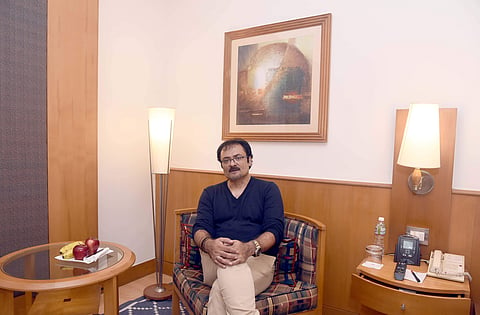

Amidst the clinking of cutlery, the persistent chatter of diners and the mellow music, I sat down for a chat with Bollywood's ace Sound Designer Bishwadeep Chatterjee at Cinnamon - Trident, Chennai recently. After the customary niceties, I requested him if I could record the interview. But before he could respond to my request, he called for the waiter — not to place his order, but to make a request of his own, "Could you please lower the volume of the music?" Who else but a National Award winner for Best Audiography (Madras Cafe and Bajirao Mastani) would understand the sensibilities of sound.
Sound design goes beyond dialogues and music recordings; it involves the soundscape of the film as a whole, especially when working with newer sound technology like Dolby Atmos. "A moviegoer must not remember the background music or the effects specifically; it should be a part of the package. If they hear the sounds distinctly, then there is something wrong," says the Bihar-born veteran, who has worked in more than 35 movies till date, his latest being Sachin: A Billion Dreams and ‘chaotic’ is the word Chatterjee uses to describe his experience. “Because it was a docudrama, the material we were working with was from different decades and not up to today's standards. So, trying to give the audio consistency was a task," he says. When Chatterjee asked Sachin Tendulkar himself how he has found the film, the master blaster said, "I did not know it could sound like that," which for him, who had toiled over the consistency of the audio, was the biggest reward.
It seems to us that life has come full circle for Chatterjee. His first job after passing out of FTII, Pune in 1984, was location recording for a documentary. His initial interest was recording music. Our conversation took us back to the early 90s when album songs (non-film music) were flourishing, "thanks to MTV and Channel V, who added a visual to this music," he reminds us. Apart from recording for iconic bands like Silk Route and Euphoria, his name is associated with ‘rainy’ numbers like Shubha Mudgal’s Ab Ke Sawan Aise Barse and Mika Singh’s Sawan Mein Lag Gayi Aag.
"Music albums kept us employed because getting into films was still restrictive," says Chatterjee, who finally got his foot into films when we worked as an Assistant Sound Recordist for. Mira Nair's Salaam Bombay. Soon his batchmates, Sanjay Leela Bansali and Rajkumar Hirani sought his expertise, by which time he was swimming against the tide as he set up a workstation (in the era of analogue technology) and was working from home. But that was then and this is now. His next is another Bhansali film, the Ranveer Singh and Deepika Padukone-starrer, Padmavati.
The recent fuss over privatisation of his alma mater FTII saddens Chatterjee as he has his reservations about it. "I could afford to go to FTII because it was subsidised. Today, there are a lot of schools which teach the same course at an exorbitant price, but in terms of quality, they are not consistent," he opines. Also, the politicisation of campuses that is affecting students saddens him. "I still don't think people realise that filmmaking is an art that requires a certain knowledge of technicalities. People don't know what to do with this subject. They know what design is, so there is no conflict in NID. They know what theatre is, so NSD is fine too," rues Chatterjee. He draws our attention to another cause of underpaid faculty and advises that teachers who can independently make films should be hired, after all, "one must always be in touch with the artist in you," he says.
Chatterjee opens up about working with these three hitmakers of the industry:
Sanjay Leela Bansali
Movies: Hum Dil De Chuke Sanam, Devdas, Bajirao Mastani
Working with Bhansali, whose attention to details is legendary, gives Chatterjee tremendous satisfaction. In fact, recording the album of Hum Dil De Chuke Sanam was what he believes brought him into the limelight. “Here is a man who knows every department of filmmaking,” Chatterjee says admiringly. From editing to choreography and composing, even the colour scheme of the set matters as Bhansali is known to pull up even an extra whose costume seems off. “I respect anybody who takes his work so seriously,” he says.
Rajkumar Hirani
Movies: Lage Raho Munna Bhai, 3 Idiots
Hirani has a different way of working, Chatterjee informs us, adding, “He is one of the finest editors in the country.” Though he doesn’t get too adventurous with the camera in terms of shots, it is the script that is the Holy Grail for Hirani, whose latest movie PK was appreciated for the same. Hirani works two to three years on the scripts, which are extremely funny, notes Chatterjee.
Shoojit Sircar
Movies: Madras Cafe, Pink, Piku
After hearing the mix that Chatterjee had made for Madras Cafe, Shoojit Sircar stood up and exclaimed, “You are going to take all the awards this year!” Chatterjee might have brushed it off then, but Sircar’s prophecy did come true and Chatterjee won his first National Award for Best Audiography. He had also worked with Sircar on Piku which he found harder as there were no wars or anything of that sort. “The sound shouldn’t get noticed, which is how it should be,” he educates us.
